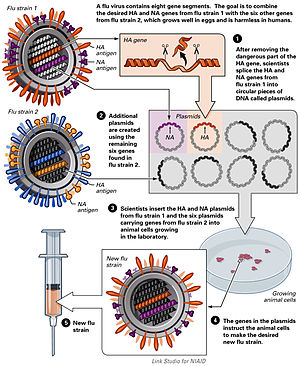
A vaccine is a biological preparation which is used to establish or improve immunity to a particular disease.
Vaccines can be prophylactic (e.g. to prevent or ameliorate the effects of a future infection by any natural or "wild" pathogen), or therapeutic (e.g. vaccines against cancer are also being investigated; see cancer vaccine).
The term "vaccine" derives from Edward Jenner's 1796 use of cowpox (Latin variolæ vaccinæ, adapted from the Latin vaccīn-us, from vacca cow), which, when administered to humans, provided them protection against smallpox.
History
The earliest vaccines were based on the concept of variolation originating in China, in which a person is deliberately infected with a weak form of smallpox as a form of inoculation. Jenner realized that milkmaids who had contact with cowpox did not get smallpox. The process of distributing and administrating vaccines is thus referred to as "vaccination". Jenner's work was continued by Louis Pasteur and others in the 19th century. Since vaccination against smallpox was much safer than smallpox inoculation, the latter fell into disuse and was eventually banned in England in 1849.
The 19th and 20th centuries saw the introduction of several successful vaccines against a number of infectious diseases. These included bacterial and viral diseases, but not (to date) any parasitic diseases.
Types

Vaccines may be dead or inactivated organisms or purified products derived from them.
There are four types of traditional vaccines:[1]
- Vaccines containing killed microorganisms - these are previously virulent micro-organisms which have been killed with chemicals or heat. Examples are vaccines against flu, cholera, bubonic plague, and hepatitis A.
- Vaccines containing live, attenuated virus microorganisms - these are live micro-organisms that have been cultivated under conditions that disable their virulent properties or which use closely-related but less dangerous organisms to produce a broad immune response. They typically provoke more durable immunological responses and are the preferred type for healthy adults. Examples include yellow fever, measles, rubella, and mumps. The live tuberculosis vaccine is not the contagious strain, but a related strain called "BCG"; it is used in the United States very infrequently.
- Toxoids - these are inactivated toxic compounds in cases where these (rather than the micro-organism itself) cause illness. Examples of toxoid-based vaccines include tetanus and diphtheria. Not all toxoids are for micro-organisms; for example, Crotalis atrox toxoid is used to vaccinate dogs against rattlesnake bites.
- Subunit - rather than introducing an inactivated or attenuated micro-organism to an immune system (which would constitute a "whole-agent" vaccine), a fragment of it can create an immune response. Characteristic examples include the subunit vaccine against HBV that is composed of only the surface proteins of the virus (produced in yeast) and the virus-like particle (VLP) vaccine against human papillomavirus (HPV) that is composed of the viral major capsid protein.
A number of innovative vaccines are also in development and in use:
- Conjugate - certain bacteria have polysaccharide outer coats that are poorly immunogenic. By linking these outer coats to proteins (e.g. toxins), the immune system can be led to recognize the polysaccharide as if it were a protein antigen. This approach is used in the Haemophilus influenzae type B vaccine.
- Recombinant Vector - by combining the physiology of one micro-organism and the DNA of the other, immunity can be created against diseases that have complex infection processes
- DNA vaccination - in recent years a new type of vaccine, created from an infectious agent's DNA called DNA vaccination, has been developed. It works by insertion (and expression, triggering immune system recognition) into human or animal cells, of viral or bacterial DNA. Some cells of the immune system that recognize the proteins expressed will mount an attack against these proteins and cells expressing them. Because these cells live for a very long time, if the pathogen that normally expresses these proteins is encountered at a later time, they will be attacked instantly by the immune system. One advantage of DNA vaccines is that they are very easy to produce and store. As of 2006, DNA vaccination is still experimental.
While most vaccines are created using inactivated or attenuated compounds from micro-organisms, synthetic vaccines are composed mainly or wholly of synthetic peptides, carbohydrates or antigens.
Vaccines may be monovalent (also called univalent) or multivalent (also called polyvalent). A monovalent vaccine is designed to immunize against a single antigen or single microorganism.[2] A multivalent or polyvalent vaccine is designed to immunize against two or more strains of the same microorganism, or against two or more microorganisms.[3]


No comments:
Post a Comment